

Barry Marchant
-
Posts
34 -
Joined
-
Last visited
Content Type
Events
Profiles
Forums
Media Demo
Posts posted by Barry Marchant
-
-
On 09/08/2019 at 01:37, Bandsaw Steve said:
Yes and I’m Waiting...waiting... waiting. 😜
Agree that this is a great idea for a group build! My dad drove vintage trams around Christchurch (NZ) for many years. Trams make beautiful, colourful and unusual subjects for models. I’m going to tackle one someday, but that could be years from now and it would take me at least a year to finish one so sadly I’ll have to pass up this group build.
Good luck with it though, I’m looking forward to watching! 👍
Hi Steve, Have you sorted out a tram plan yet? Quite a number at Whiteman Park to choose from, and a local modeller they may have a contact for, but I do not have a contact for him. Select a plan and I may be able to help with detail, and a very nice model of Carpathia that you made, congratulations.
-
 1
1
-
-
For those of you who have found these tram models interesting, you should go to your library and ask to borrow the book "Always a Tram in Sight" by Graham Stewart. this is THE book on NZ electric trams and describes all but 1 or 2 very early works cars, and the systems on which they worked.
All but 1 type of Christchurch electric tram and 4 types of trailer are preserved at Ferrymead Heritage Park, also a Kitson steam tram (No 7, makers number 26 of 1881 vintage) in working order.
-
 1
1
-
-
16 hours ago, Martian Hale said:
Nice work on the wake Steve. Of course, if its the actual night to remember she is going to need that lighting we all voted for. Does anyone have any ideas who we can get to perform the grand switching on of said illuminations? It clearly needs to be some sort of celebrity.
Martian 👽
What about Steve's Wife, who has been a long time observer of all the activity on this model?
Very nice work Steve, keep it up. We wait anxiously to see the final result when you are satisfied with it!!
regards, Barry.
-
 1
1
-
-
3 hours ago, Bandsaw Steve said:
Excellent! And I recognise the background in that photo as well. 👍
Thank you.
I should have 'doctored' the original by removing the background and substituting a photo of a blue sky with patches of cloud to give it atmosphere. Tried it before and it works well!
BTW I believe the concrete block background is to be painted a suitable blue shortly!!!!!!!!
-
 1
1
-
-
On 12/02/2019 at 23:00, Bandsaw Steve said:
Always interested to see your work Barry. The ‘Exploded’ view is highly instructive. Will get round to doing one of these one day. Promise. 🤞
Now for some Steam tram photos, Not 'exploded' views but a disassembled one! ( No 7 was the only one to actually explode but that was c1897) It was subsequently rebuilt and is now in regular service at Ferrymead Heritage Park in Christchurch as shown below. I have now made 2 models of it.

Why 2, you may ask. Well I have a friend who, every time he saw mine running on his layout would say 'I must make one of those when I get around to it' so I got a round to-it for him and made No. 2, it being the second one. Mine is No 5 because that number was easy to paint. There were 8 Kitsons running in Christchurch at the end of the 19th century.

Now, how do they go together?

Top: the roof with water tanks in place and the funnel fitted.
Left: the 'boiler' with steam dome on top, mounted on the floor of the model.
Right: the complete body sides and ends.
Lr left: the skirts which hide the motion. The 'knob' on each end is the towing point for trailers. These skirts are closer in shape to the originals of the 1880s.
Lr right: The Works. Motor drives 1 axle via worm and pinion,the O ring between the 2 axles transmits the drive for traction purposes. The O ring runs in a groove turned on the inside of these wheels which are not insulated. The other side wheels are fitted with a nylon bush and the power pickups can just be seen.
Botton: 2x 4x3/8 screws which hold the whole thing together.
-
 4
4
-
-
Looks pretty good Steve. Now I know NOT to try ship modelling!!
-
 1
1
-
-
7 hours ago, Bandsaw Steve said:
Whoops - just checked. It is spelt ‘Rangatira’ not ‘Rangitira’ as I thought. 🥵
I’m so ashamed. Obviously been in Australia too long. 😳
Oops, I did not know the name had been used several times.I remember the names of the ships used on the inter island run. Maori had his Wahine, then Rangatira, Hinemoa, Maori again and Wahine that capsised with great loss of life.
Barry
-
 2
2
-
-
23 hours ago, Bandsaw Steve said:
Hi Steve,
just preempted you there and was busy doing a google search myself. NZ maritime records have SS Pakeha as sister ship of SS Rangitira so there should be lots of info available. I would post a link but am not sure how to do using a phone. (I generally post using a computer but not today). There is a basic profile section drawing of Rangitira available too if you google ‘SS Rangitira plans’. Were Mahana and Mahia constructed as sister-ships or merely operated as sister ships? The NZ maritime records site is quite specific that Pakeha and Rangitira were built as sisters.
Pakeha does look a lot like Carpathia. I reckon the hull shape would be near identical. Pakeha however appears to have fewer masts and lacks the forward island superstructure.
I reckon she would be a great subject. 👍
Steve
From my file of useless information I think there is a large scale model of the inter island steamer Rangitira in the Canterbury Museum. Looking for it should fill in tomorrow pm. Sailed on it a number of times as a kid. During the war its departure time from Wellington or Lyttelton was never announced and it never missed a sailing except as follows. It hit Barrets reef going into Wellington once (1942?), reversed off, did a u turn and steamed up the harbour full astern, reached the wharf and sat on the bottom. It was duly salvaged and repaired. After the war the residents of Lyttelton set their clocks by the ferry arrival.
Barry
-
 2
2
-
-
On 27/01/2019 at 06:46, lordairgtar said:
Interesting subject. I noticed right away the differing sized wheels. Was this common in NZ. Nothng American used that style as I can see. I live near a trolley museum where one can ride the trams along a small stretch of track. Cool stuff.
Hello Lordairgtar,
This type of truck was used in NZ and UK and elsewhere. It was an effort to give a smoother ride on a long car than a single truck would, but without the complications involved in wiring 4 motors as would be involved if 2 ordinary trucks were fitted. The large wheels were on the driving axles and the small (pony) wheels gave the trucks turning ability.
The driving axles carried <> 60% of the car weight and the truck pivot point is closer to the driving axle than the pony axle, In NZ such trucks were used in Christchurch, Wellington, Dunedin. At Crich the Hill Of Howarth car is also fitted with them. The Ferrymead tramway in Christchurch has a number of cars requiring these trucks, but none being available world wide, They have set up to produce new replicas from scratch using motors obtained from overseas and casting new steel parts from their own patterns. So far, 2 pairs are in regular use and more are to be constructed.
My models have wheels turned to scale, all trucks being identical. See the decker above.
Makers I am aware of are Peckham and Brill.
-
 1
1
-
-
4 hours ago, bar side said:
Ahhhh!! thank you Barside, there are none so blind as those that will not see! I did not read the Village Photos instructions correctly.
This is a model of a Christchurch 'Hills' tram of which several were built in the early 20th century. They were fitted with Peckham 14d5 trucks and powerful motors which enabled them to climb the 1:11 grade up Hackthorne Road, Cashmere, Chch.
Two of them headed the last ceremonial trams in Christchurch in 1954, And No 24 is now being rebuilt at Ferrymead, Christchurch
The photo below shows the various components pre assembled ready to make the finished model.
From the top..... 2 advertising boards for the roof.
the roof
2 driver's cabins
the main body, (saloon on the right)
the main floor unit with trucks under, only the motor showing.
2 floor units for drivers cabins
The 2 poles and truck side frames have yet to be made, but it runs.

-
 4
4
-
-
Can someone please tell me why the photo with this reference will not display?
http://village.photos/members/Barry/Trams/468950/IMG_0066
TIA
Problem now solved, thanks.
-
Hi,
I have just found that some of my photos have vanished from Britmodeller. These were linked to photos on my website which has now been deleted by Vodafone NZ. I thought that Britmodeller copied the files, but it now appears that they were only linked. Is this correct, or have I made an error somewhere?
TIA Barry
-
35 minutes ago, Bandsaw Steve said:
Noted!
It’s not often that I have too much power - my wife makes sure of that! 🤪
Lucky Man!!!!
-
 2
2
-
-
On 09/01/2019 at 21:55, Bandsaw Steve said:
Actually when considering my Britmodeller name I nearly went with ‘Wood Butcher’ so I would have to agree with you on the point regarding butchery!😁
Will be getting a cylindrical sanding attachment and possibly a sanding ball for my Dremmell on the strength of your recommendation. 👍
Thats good, but watch the power of the dremel. My mini drills are much less powerful and I prefer them 2 your Dad's dremel!!!! Too much pressure and the dremel takes over too quickly!
Good carving,
Barry.
-
 1
1
-
 1
1
-
-
Hi Steve, a wood rasp is a butchers instrument no matter what you touch with it. Look at the canopies on my tram models, they are finished using a drum sander on a mini drill and it can do outside or inside curves down to abt 10mm radius. Metal sanding balls are also available.
A nice model, when is the launching party?
Regards, Barry
ps... still can't get flickr to perform, any ideas pls???
-
 1
1
-
-
On 19/06/2018 at 09:29, Ian T said:
It’s great to see something really different and so good!!
Thanks Ian, Trams are certainly different in the modelling world, so many advantages.
1:32 scale suits my eyesight! I have a complete layout on a 8x4 base, so many prototypes to choose from, 1 single tram is a complete unit, Tight curves.
I wish more modellers would choose this subject.
There are plenty of trams at Ferny Grove you could model, I will put up Colin's Brisbane dropcenter for you shortly.
-
 1
1
-
-
 The side of the tram says it all! The original is a Melbourne W2 considerably modified inside and painted in this striking colour scheme. It does daily meal trips around the city circuit most evenings and a booking for a meal is essential.The power truck has both axles powered. Working headlights and side lights are fitted and powered with a 9 volt battery hidden in the kitchen area. This model, made by Barry can run on either Colin's or my layout.
The side of the tram says it all! The original is a Melbourne W2 considerably modified inside and painted in this striking colour scheme. It does daily meal trips around the city circuit most evenings and a booking for a meal is essential.The power truck has both axles powered. Working headlights and side lights are fitted and powered with a 9 volt battery hidden in the kitchen area. This model, made by Barry can run on either Colin's or my layout.
The truck side frames are Chch Brill 77e castings. They should be Melbourne No 1 or 1a but I do not know where to source them. Help welcomed on this matter
-
 4
4
-
-
On 21/05/2018 at 08:42, Spiny said:
Looks great, even better when you consider it moves under it's own steam (as it were).
I don't know a lot about the Christchurch tram system (it wasn't running when I was out there), but do they ever run the old trams such as these or is it just new stuff?
Hello Spiny, if you google for Christchurch Trams, or Ferrymead Tramway you should get a lot of leads.
Both tramways are a 'must see' if you visit us. There are no 'new' trams' in Christchurch, several have been rebuilt completely from abandond wrecks.
Actually, in 1905 it was indirectly steam powered! The whole system was powered by a big steam generating plant boosted by batteries. (reputedly the biggest such plant in the souther hemesphere) In 1916 there was a massive failure in the State Electricity system and the CTB took over the whole of the emergency supplies in Christchurch Boilers were cold when the request came in and they picked up the first emergency load within about an hour!
-
 3
3
-
-
13 hours ago, bar side said:
Nice build. What do you use to power it? Driven bogies I guess but adapted axels for the new rack gauge?
Hi bar side, one truck is powered, on 1 axle by a Mashima 12 volt motor through a worm and pinion obtained from North Yard based in Blenheim NZ (see their catalog) The axles are 3mm bright steel bar purchased in long lengths and cut to length (1 15/16in )
Insulated wheels are fitted with a 10mm nylon bush drilled 3mm while still in the lathe and the axle pressed in.
Live wheels are turned with a bush on the inside which is drilled and tapped for a grub screw Meccano style
Track gauge is 45mm or 1.75 inches (gauge 1) but MUCH finer than garden railway track.
Pickup is from the rails of course.
-
 2
2
-
-

 Posted Friday at 16:07 (edited)
Posted Friday at 16:07 (edited)
My model of a Christchurch double deck tram as built 1905. The trolley pole had been removed when this photo was taken. Usually the model appears after the original was built, but in this case the model came first! It was then used to persuade the unbelievers how the seating should be arranged on No 26 at Ferrymead.This is a good example of scratch building! The trolley standard is the barrel of a ball point pen, the netting around the top deck is a length of fly screen netting as used on a flyscreen door! and the windows are cut from a soft drink bottle with straight sides. Stairs were cut from a block of customwood with a fret saw. The pole (not shown) was made from a double-butted bike spoke and fitted with a trolley head and base. Wheels are the correct scale size. The truck side frames were made from two excellent patterns carved by Colin. These were embedded in plastersene and hardened in the freezer (don't tell mum!) over night. Next morning the patterns were removed from the moulds to be replaced with builders bog. The result is a set of 14D5 side frames to match the full size originals. Unfortunately the aprons are still missing their wooden tops. I think the driver has escaped to have a cuppa.
The model runs very nicely and will tow a trailer.
-
 12
12
-
-
Thanks for the tip Steve. I have now copied the items about the Decker to where you suggest and will add more photos there.
We did a countup of the numbers - I have 15 models, only 1 type duplicated. Duplicated (a) to show the different liveries used over the years, and (b) to replicate what was common practice on the streets of Christchurch in the 1940s and fifties when I was young and the Brills towed 2 trailers on some routes.
At last count Colin has >25, all runners, and spread over various systems.
Must meet up for a propper pow wow next time you visit The Mainland.
-
 1
1
-
-
Models of Trams (streetcars) made by Barry and Colin. All are completely scratch built, to the scale of 1:32 and run on 45mm track (handlaid using HO rail with the sleepers removed and the base built up to represent street scenes.),not garden railway track.
-
 1
1
-
-
-
My model of a Christchurch double deck tram as built 1905. The trolley pole had been removed when this photo was taken. Usually the model appears after the original was built, but in this case the model came first! It was then used to persuade the unbelievers how the seating should be arranged on No 26 at Ferrymead.
This is a good example of scratch building! The trolley standard is the barrel of a ball point pen, the netting around the top deck is a length of fly screen netting as used on a flyscreen door! and the windows are cut from a soft drink bottle with straight sides. Stairs were cut from a block of customwood with a fret saw. The pole (not shown) was made from a double-butted bike spoke and fitted with a trolley head and base. Wheels are the correct scale size. The truck side frames were made from two excellent patterns carved by Colin. These were embedded in plastersene and hardened in the freezer (don't tell mum!) over night. Next morning the patterns were removed from the moulds to be replaced with builders bog. The result is a set of 14D5 side frames to match the full size originals. Unfortunately the aprons are still missing their wooden tops. I think the driver has escaped to have a cuppa.
The model runs very nicely and will tow a trailer.
-
 1
1
-

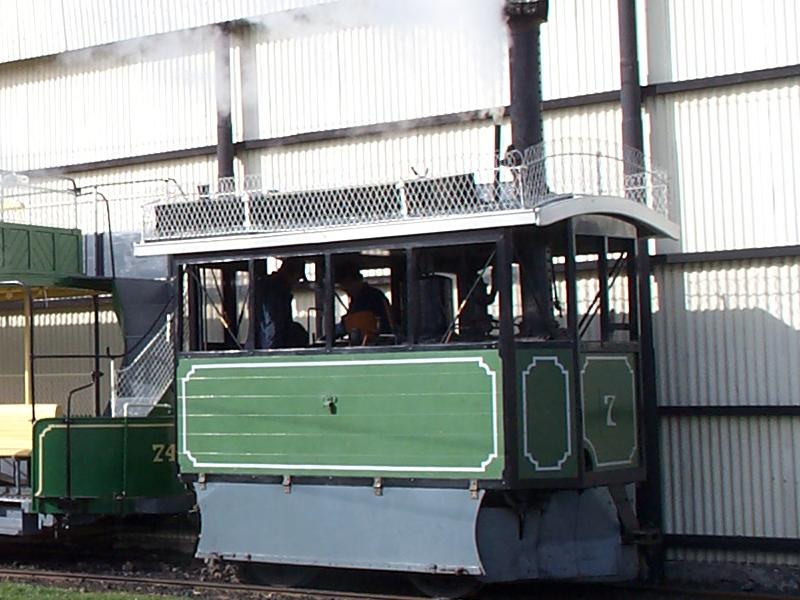
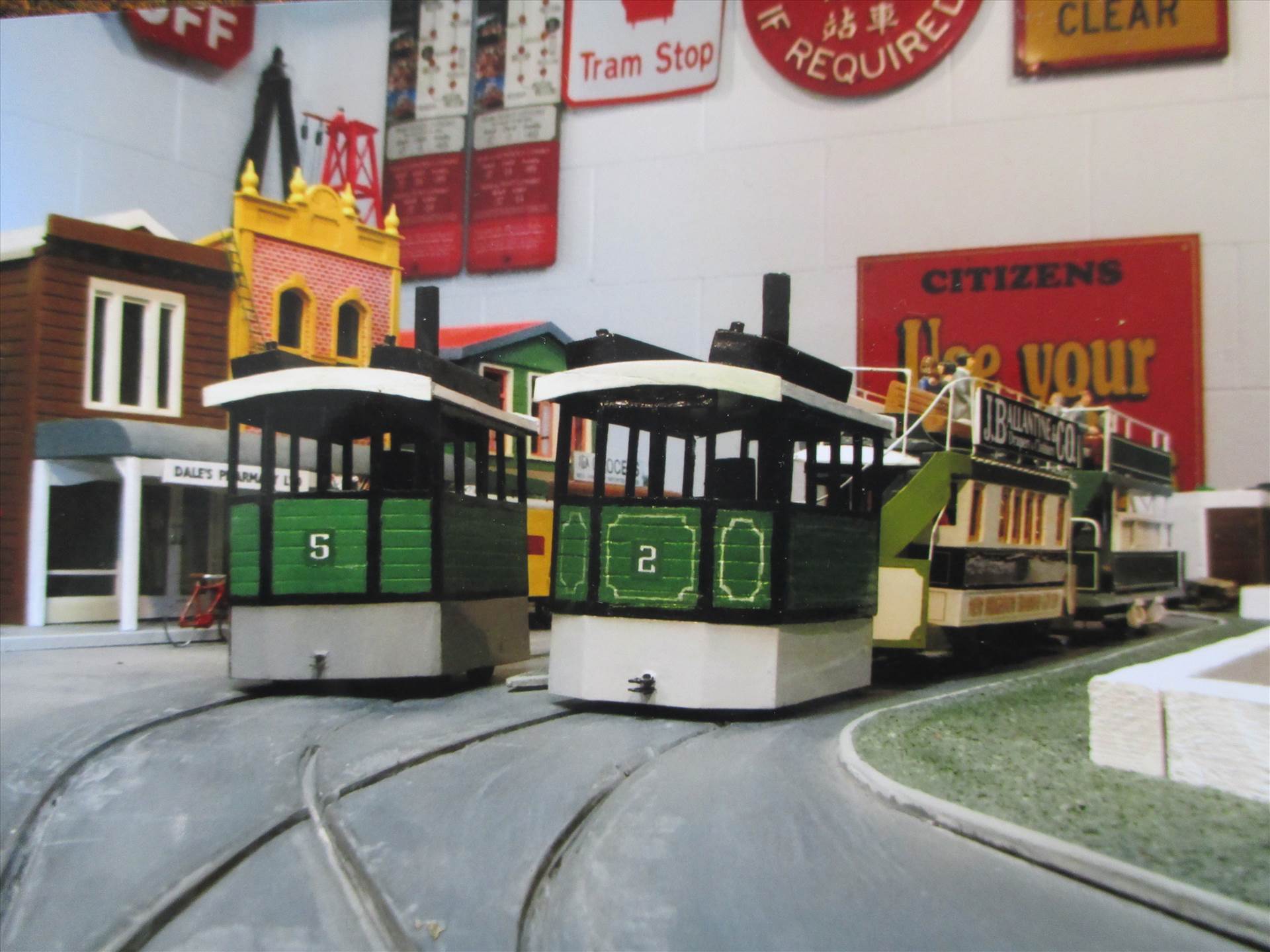
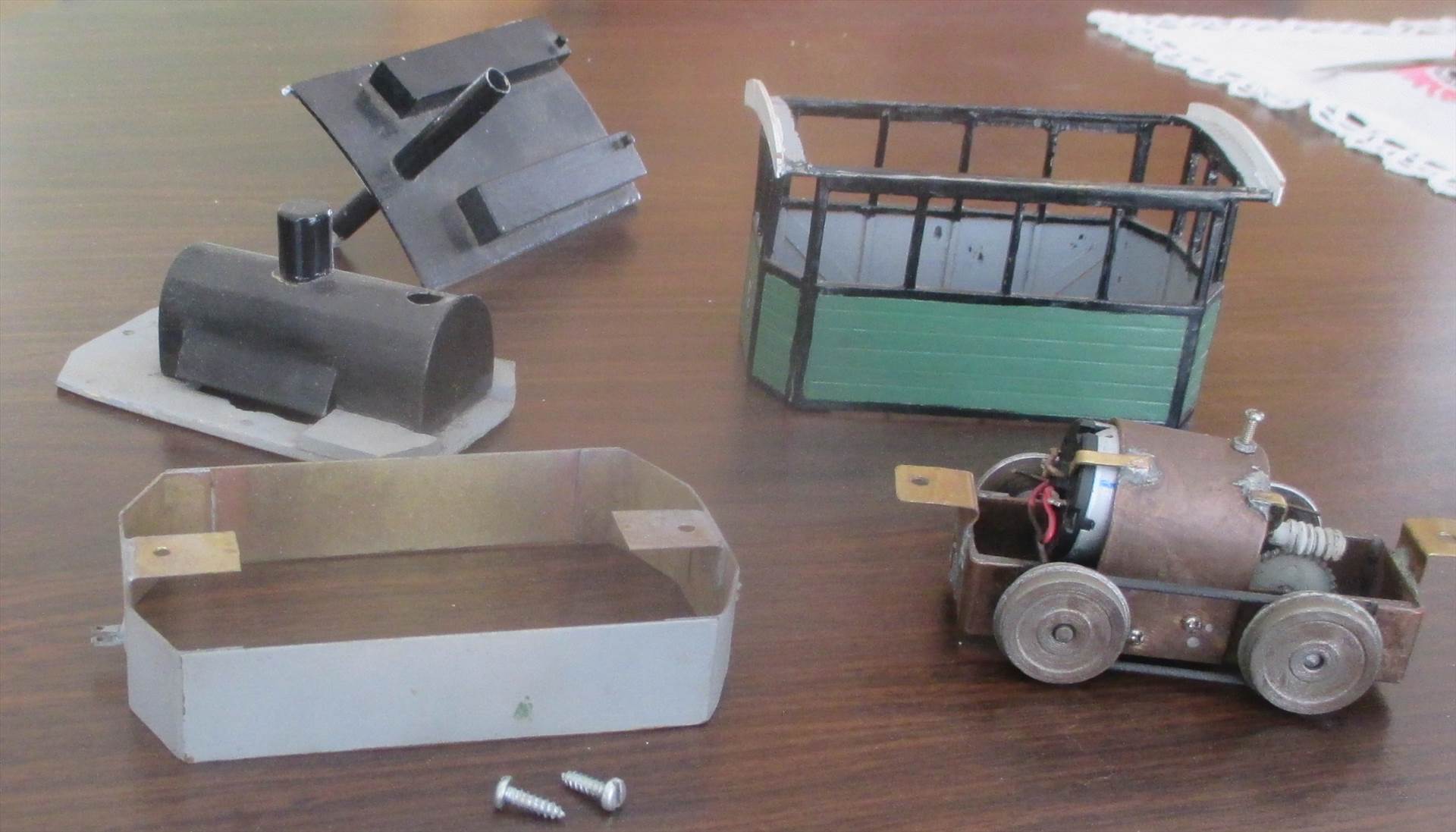
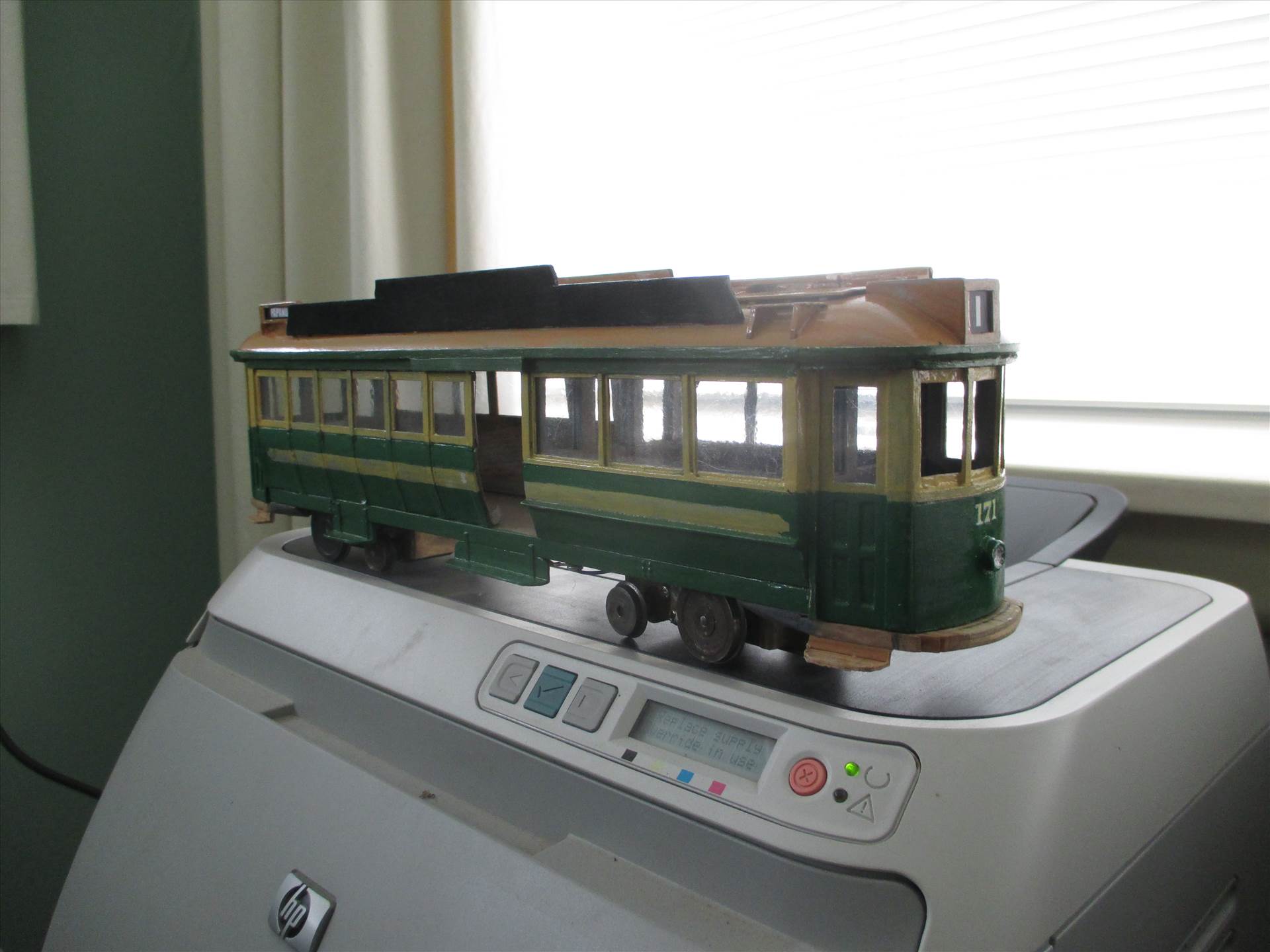
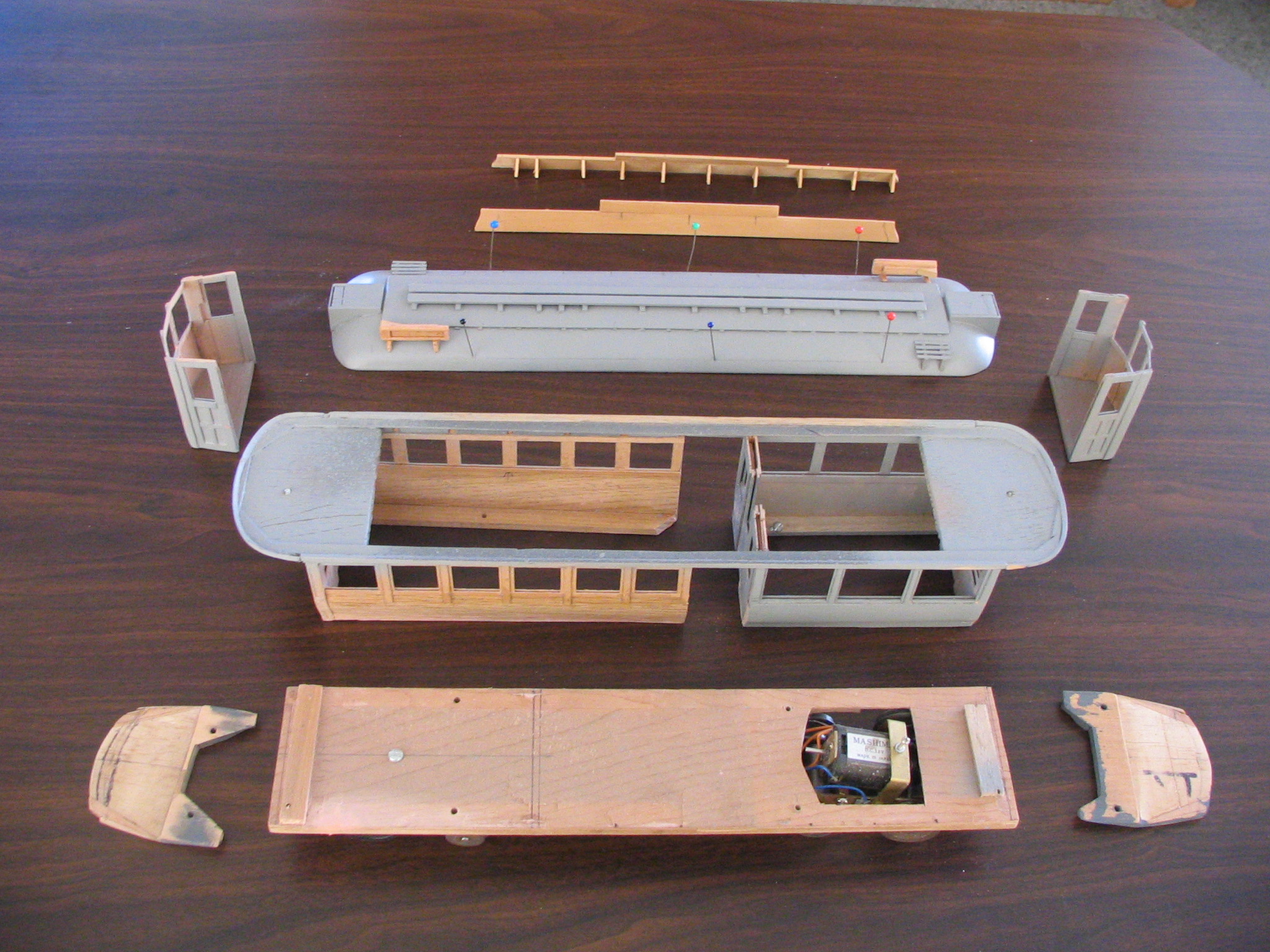
 The side of the tram says it all! The original is a Melbourne W2 considerably modified inside and painted in this striking colour scheme. It does daily meal trips around the city circuit most evenings and a booking for a meal is essential.The power truck has both axles powered. Working headlights and side lights are fitted and powered with a 9 volt battery hidden in the kitchen area. This model, made by Barry can run on either Colin's or my layout.
The side of the tram says it all! The original is a Melbourne W2 considerably modified inside and painted in this striking colour scheme. It does daily meal trips around the city circuit most evenings and a booking for a meal is essential.The power truck has both axles powered. Working headlights and side lights are fitted and powered with a 9 volt battery hidden in the kitchen area. This model, made by Barry can run on either Colin's or my layout.
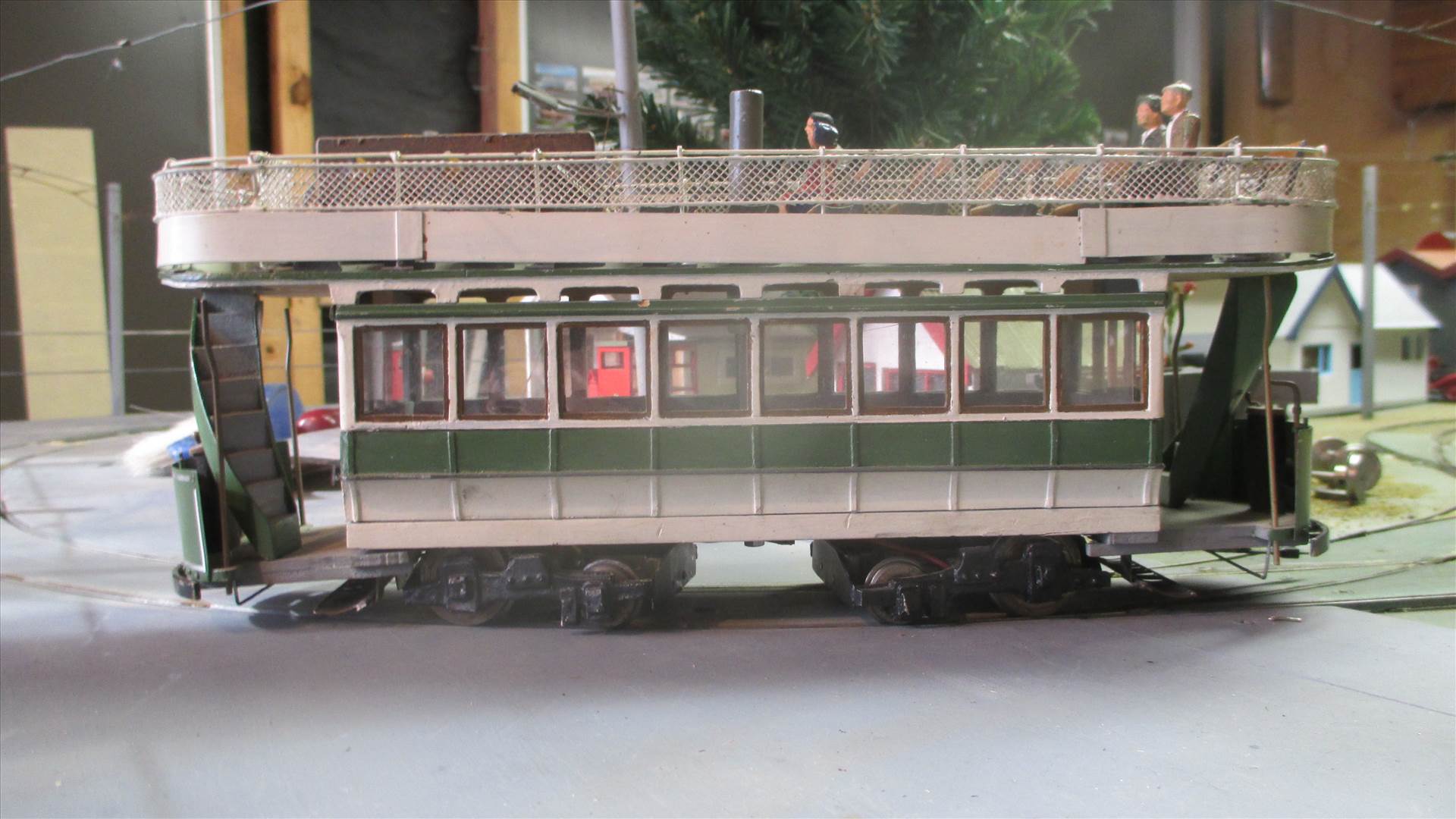
 Posted Friday at 16:07 (edited)
Posted Friday at 16:07 (edited)
Equipment of my Family.
in Group Build Chat 2020
Posted
1st step is the floor. 10in thick = 5/16in, Open section 1st length inc the thickness of 2 centre bulkheads; 2&3, 2 saloon floors inc end bulkheads, screw bulkhead floors on top of centre section. Next the 2 drivers platforms which go under the saloon floors.Draw centre lines along each piece for reference, send s photo pls.
have fun,regards, Barry